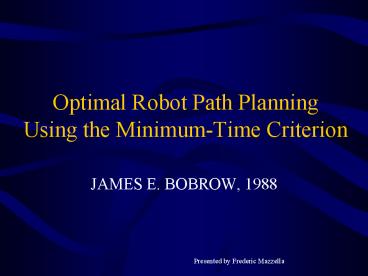Optimal Robot Path Planning Using the MinimumTime Criterion - PowerPoint PPT Presentation
1 / 24
Title:
Optimal Robot Path Planning Using the MinimumTime Criterion
Description:
Presented by Frederic Mazzella. Optimal Robot Path Planning. Using the Minimum ... Geometric path represented as a set of parameterized interpolation functions ... – PowerPoint PPT presentation
Number of Views:104
Avg rating:3.0/5.0
Title: Optimal Robot Path Planning Using the MinimumTime Criterion
1
Optimal Robot Path Planning Using the
Minimum-Time Criterion
- JAMES E. BOBROW, 1988
Presented by Frederic Mazzella
2
OUTLINE
- INTRODUCTION
- OPTIMIZATION PROCEDURE
- NUMERICAL EXAMPLES
- DISCUSSION
- CONCLUSIONS
3
INTRODUCTION
4
- Usual problems in robot motion generation
- - Collision-free path planning
- - Time-optimal control
- - Vision-based path planning
- - Feedback control
- Our concern A collision-free path which gives
the minimum-time motion.
5
- We know
- An initial collision-free path
- The manipulator equations of motion
- The workspace
- We want
- A parameterized time-optimal path
- (i.e. an optimal trajectory)
- How?
- By optimization of the initial feasible path
6
- Why?
- Because distance is a bad (but often used)
criterion to select a path.
7
OPTIMIZATION PROCEDURE
8
Method
- Geometric path represented as a set of
parameterized interpolation functions - Parameters are varied to minimize the path
traversal time
9
3D-path representation
- Uniform cubic B-spline polynomials
- For each spatial dimension x, we have
- And then we optimize the parameters Vi
- B-spline shape
10
Advantages of this representation
- Computational efficiency
- Only 4 non-zero terms in the above formulation
- Local control of the path shape
- Any position influenced by its 4 closest
neighbours only
11
Optimization
- The path of the end-effector is defined entirely
by the parameter s - Optimization find the B-spline vertices Vi that
define a path that minimizes the time
12
Conditions to satisfy
- Satisfy the robot equations of motion
- Admissible torques and forces (Inertia compute
the maximum velocity and keep the robot on path) - Satisfy the bounds of each joint
- Collision avoidance
13
NUMERICAL EXAMPLES
14
Two-link planar motion in the vertical plane
15
First optimization
- Path broken in two uniform cubic B-spline
intervals. - X and Y of the center vertex are the parameters
to be varied during minimization (30 iterations)
16
Optimal velocity profiles
17
Optimal paths with 1, 3, 5, and 8 intermediate B
-spline vertices
- Traversal times
- 1 Tf 0.428 sec
- 3 Tf 0.423 sec
- 5 Tf 0.420 sec
- 8 Tf 0.418 sec
- Computation time approximately linear in the
number of vertices used
18
3D path with obstacle
19
DISCUSSION
20
Regularization
- Regularization was used to eliminate some local
minima problems by optimizing J(v) - Where C(v) is the total path curvature
- Penalizes highly curved
- or irregularly shaped functions
21
Optimal path?
- Has the path converged to the true optimal?
- Who knows??? The experiments showed it seemed to
converge, but this does not mean it was
converging towards the optimal path
22
Number of vertices to use?
- The traversal time is first greatly reduced with
only few vertices - The addition of more vertices only slightly
decreases the time
23
CONCLUSIONS
24
- Off-line path planning method which iteratively
computes time-optimal paths - Uses full nonlinear equations of motion
- B-spline representation of the geometric path
- Path geometry optimized with a general-purpose
nonlinear constrained optimization program - Obstacle avoidance included in the algorithm































